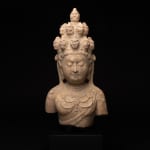Sui Marble Sculpture of Eleven-Headed Avalokitesvara, 581 CE - 618 CE
Marble
53.3 x 26.7 cm
21 x 10 1/2 in
21 x 10 1/2 in
HK.2030
Further images
-
(View a larger image of thumbnail 1
)

-
(View a larger image of thumbnail 2
)

-
(View a larger image of thumbnail 3
)

-
(View a larger image of thumbnail 4
)

-
(View a larger image of thumbnail 5
)

-
(View a larger image of thumbnail 6
)

-
(View a larger image of thumbnail 7
)

-
(View a larger image of thumbnail 8
)

-
(View a larger image of thumbnail 9
)

-
(View a larger image of thumbnail 10
)

This is a marble sculpture of eleven-headed Avalokitesvara. Dressed in conventional jewelled bodhisattva outlook with a nicely preserved keyura in front of his chest, Avalokitesvara has ten wrathful countenance on...
This is a marble sculpture of eleven-headed Avalokitesvara. Dressed in conventional jewelled bodhisattva outlook with a nicely preserved keyura in front of his chest, Avalokitesvara has ten wrathful countenance on top of his crown. Peacefully smiling, his slender facial features create a serene aura.
There are a number of different forms and traditions of the Eleven-faced Avalokitesvara. The original Sanskrit source literature is the Arya Avalokiteshvara Ekadashamukha Nama Dharani. In this text there is only a mention of the eleven faces with no mention of colour or arrangement of the faces. There is also no mention about arms, or number of arms. However, in artistic practice the eight-armed form and thousand-armed form have established themselves as the mainstream. Thus, it is possible that this sculpture has more than two arms originally.
It is impossible to determine with utmost certainty what this sculpture’s original gestures are since the hands are not preserved. Yet, from the angle that his arms extend, it is plausible to assume that his hands were in abhaya and varada mudra, which is a typical feature of Northern Dynasties and Sui style.
There are a number of different forms and traditions of the Eleven-faced Avalokitesvara. The original Sanskrit source literature is the Arya Avalokiteshvara Ekadashamukha Nama Dharani. In this text there is only a mention of the eleven faces with no mention of colour or arrangement of the faces. There is also no mention about arms, or number of arms. However, in artistic practice the eight-armed form and thousand-armed form have established themselves as the mainstream. Thus, it is possible that this sculpture has more than two arms originally.
It is impossible to determine with utmost certainty what this sculpture’s original gestures are since the hands are not preserved. Yet, from the angle that his arms extend, it is plausible to assume that his hands were in abhaya and varada mudra, which is a typical feature of Northern Dynasties and Sui style.









